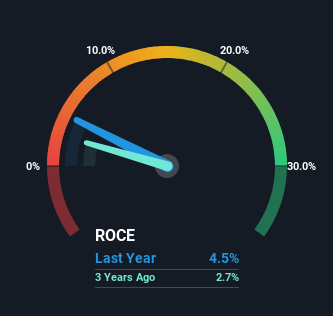Stock Analysis
- Romania
- /
- Food and Staples Retail
- /
- BVB:RPH
Here's What's Concerning About S.C. Ropharma's (BVB:RPH) Returns On Capital

Finding a business that has the potential to grow substantially is not easy, but it is possible if we look at a few key financial metrics. In a perfect world, we'd like to see a company investing more capital into its business and ideally the returns earned from that capital are also increasing. This shows us that it's a compounding machine, able to continually reinvest its earnings back into the business and generate higher returns. However, after investigating S.C. Ropharma (BVB:RPH), we don't think it's current trends fit the mold of a multi-bagger.
What Is Return On Capital Employed (ROCE)?
For those who don't know, ROCE is a measure of a company's yearly pre-tax profit (its return), relative to the capital employed in the business. Analysts use this formula to calculate it for S.C. Ropharma:
Return on Capital Employed = Earnings Before Interest and Tax (EBIT) ÷ (Total Assets - Current Liabilities)
0.045 = RON15m ÷ (RON767m - RON438m) (Based on the trailing twelve months to June 2023).
So, S.C. Ropharma has an ROCE of 4.5%. Ultimately, that's a low return and it under-performs the Consumer Retailing industry average of 11%.
See our latest analysis for S.C. Ropharma

Historical performance is a great place to start when researching a stock so above you can see the gauge for S.C. Ropharma's ROCE against it's prior returns. If you're interested in investigating S.C. Ropharma's past further, check out this free graph of past earnings, revenue and cash flow.
The Trend Of ROCE
In terms of S.C. Ropharma's historical ROCE movements, the trend isn't fantastic. Around five years ago the returns on capital were 7.1%, but since then they've fallen to 4.5%. Although, given both revenue and the amount of assets employed in the business have increased, it could suggest the company is investing in growth, and the extra capital has led to a short-term reduction in ROCE. And if the increased capital generates additional returns, the business, and thus shareholders, will benefit in the long run.
On a side note, S.C. Ropharma's current liabilities are still rather high at 57% of total assets. This can bring about some risks because the company is basically operating with a rather large reliance on its suppliers or other sorts of short-term creditors. While it's not necessarily a bad thing, it can be beneficial if this ratio is lower.
The Key Takeaway
In summary, despite lower returns in the short term, we're encouraged to see that S.C. Ropharma is reinvesting for growth and has higher sales as a result. However, despite the promising trends, the stock has fallen 26% over the last five years, so there might be an opportunity here for astute investors. So we think it'd be worthwhile to look further into this stock given the trends look encouraging.
On a separate note, we've found 2 warning signs for S.C. Ropharma you'll probably want to know about.
While S.C. Ropharma may not currently earn the highest returns, we've compiled a list of companies that currently earn more than 25% return on equity. Check out this free list here.
Valuation is complex, but we're helping make it simple.
Find out whether S.C. Ropharma is potentially over or undervalued by checking out our comprehensive analysis, which includes fair value estimates, risks and warnings, dividends, insider transactions and financial health.
View the Free AnalysisHave feedback on this article? Concerned about the content? Get in touch with us directly. Alternatively, email editorial-team (at) simplywallst.com.
This article by Simply Wall St is general in nature. We provide commentary based on historical data and analyst forecasts only using an unbiased methodology and our articles are not intended to be financial advice. It does not constitute a recommendation to buy or sell any stock, and does not take account of your objectives, or your financial situation. We aim to bring you long-term focused analysis driven by fundamental data. Note that our analysis may not factor in the latest price-sensitive company announcements or qualitative material. Simply Wall St has no position in any stocks mentioned.
About BVB:RPH
S.C. Ropharma
S.C. Ropharma S.A. operates a chain of pharmacies in Romania.
Excellent balance sheet and slightly overvalued.

